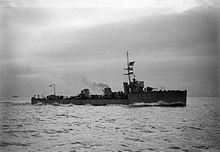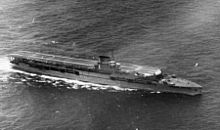HMS Acasta (H09)
|
||||||||||||||||||||||
|
||||||||||||||||||||||
|
||||||||||||||||||||||
|
||||||||||||||||||||||
HMS Acasta (H09) was 1930, the second in service destroyer of the A-Class of the British Royal Navy , who in World War II was lost 1940th
The destroyer was awarded the Battle Honors "Atlantic 1939-40", "Norway 1940" and "Scharnhorst action 1940". While defending the aircraft carrier Glorious , the Acasta was sunk by German battleships on June 8, 1940 . Before its sinking, the destroyer hit a torpedo on the Scharnhorst , which forced the Germans to break off their advance.
History of the ship
The new destroyer was the fourth ship in the Royal Navy to be named Acasta . Its predecessor was a destroyer also built by John Brown & Co., which was in service with the Royal Navy from 1912 to 1921 and was the namesake of the Acasta class comprising 20 destroyers , which were built from 1912 to 1914.
Construction began the ordered on 6 March 1928 the new building August 13, 1928. The ship ran on August 7, 1929 as part of the first class destroyer of the Royal Navy after the end of the First World War, was built at John Brown & Company in Clydebank from Stack. It was commissioned on February 11, 1930 as the second ship of the class. The experiences with the two previously built prototypes Ambuscade and Amazon flowed into the planning and construction of the new class.
Mission history
The Acasta replaced initially together with her sister ships in the Mediterranean Fleet in the third destroyer flotilla older destroyers of the V- and W-Class . From April 1930 the Acasta was in service in the Mediterranean. In August 1932, the ship returned home for two months to be overhauled in Devonport . On July 12, 1934, the destroyer collided with its flotilla commander Codrington . The necessary repairs could be carried out on site in Malta .
In 1937 the A-class destroyers were replaced by the new I-class destroyers . The Acasta underwent a major overhaul and was assigned to the reserve at Devonport in May 1937. From March 1938 she served in the local destroyer flotilla in Plymouth . In March 1939, the destroyer took on the same tasks in Portsmouth, where the sister ship Antelope was stationed. There the destroyer was temporarily assigned to the Argentinian school cruiser La Argentina to support the acceptance tests.
War missions
At the beginning of the World War, the local units were converted into further destroyer flotillas. So the ship came to the now in Plymouth newly formed "18th Flotilla ”deployed in the English Channel and the south-west access routes to the British Isles. The tasks included securing convoys in this area, including in particular the troop transports to France .
In April 1940, the destroyer was used in the attempted defense against the German landing in Norway ( Operation Weser Exercise ) to cover ships of the Home Fleet together with the Codrington and the Ardent . In May she belonged with other units to secure the badly damaged Penelope on her return from the Skelfjord makeshift repair base to Great Britain. At the end of May, the Acasta returned to Norway with the destroyers Highlander , Diana , Ardent and Acheron as a safety shield for the aircraft carriers Ark Royal and Glorious .
The end of the acasta
When Northern Norway was evacuated because of the German offensive on the western front ( Operation Alphabet ), the destroyer and the Ardent were supposed to lead the Glorious back to Scapa Flow , which had taken land planes previously stationed in Norway on board.
On June 8, 1940, the German battleships Scharnhorst and Gneisenau surprised the group west of the Lofoten , despite good visibility , and sank after a two-hour battle ( Operation Juno ). Both destroyers defended the aircraft carrier with full engagement, but ultimately unsuccessfully, through torpedo attacks and the laying of smoke walls. However, after Glorious was sunk, Acasta succeeded in damaging Scharnhorst with a torpedo hit so that the battleships had to abort their operation. This prevented losses from the other convoys.
The destroyer decreased after many hits the center of the German artillery warships to 68 ° 45 '0 " N , 4 ° 30' 0" O . Only one survivor of the destroyer's crew was rescued due to communication problems between the British ships. The small Norwegian steamer Borgund , which passed the sinking point, rescued this and 38 other survivors of the Glorious , which she gave ashore in Tórshavn in the Faroe Islands on June 14th. Twelve other castaways were later rescued by Norwegian aid ships and a German emergency aircraft sent to the sinking site. Five days after the sinking, the German machine found two Ardent survivors , one of whom soon died from exhaustion.
Individual evidence
- ↑ a b c d e Service History HMS Acasta
- ^ Rohwer: Sea War. June 4-10, 1940, Norway; Company Juno
- ^ D / S Borgund
literature
- Michael J. Whitley: Destroyers of World War Two. An international encyclopedia. Arms and Armor Press, London et al. 1988, ISBN 0-85368-910-5 .
- John English: Amazon to Ivanhoe: British Standard Destroyers of the 1930s. World Ship Society, Kendal (1993), ISBN 0-905617-64-9 .


